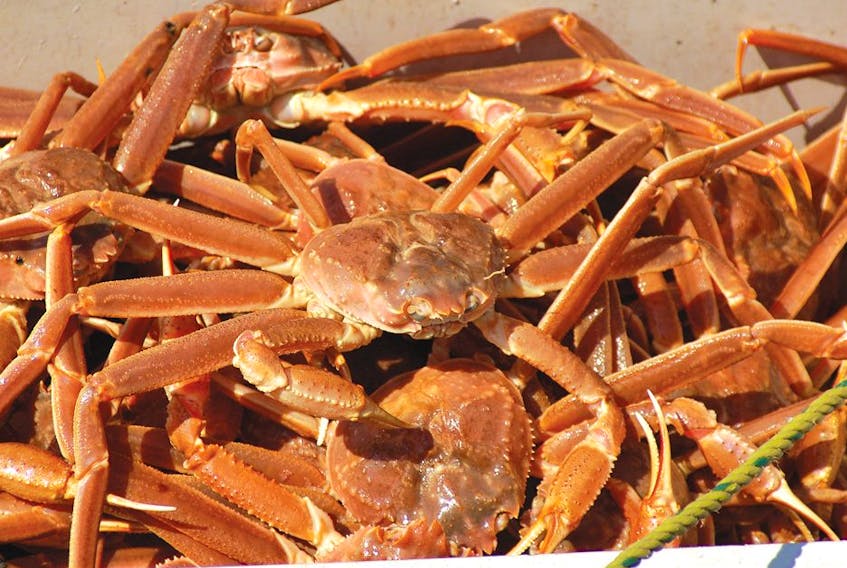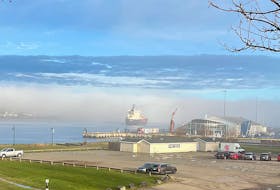The snow crab fishery should continue to be an economic bright spot for the Newfoundland and Labrador economy in 2021.
The latest report from Fisheries and Oceans (DFO) science shows modest improvements in snow crab biomass in several fishing zones around the province.
The good news from science is that the snow crab stocks appear to be recovering in some areas.
In a technical briefing for media Friday, Julia Pantin, DFO’s lead biologist for snow crab in the Newfoundland region, said the population of crabs becoming available to the fishery is expected to increase over the new two to four years in most areas.
And all snow crab assessment divisions are above the Limit Reference Points for the stock. That means the population of snow crab is above the limit where fishing could seriously affect the stock.
Pantin noted, however, the exploitable biomass is still at low levels, compared to previous years.
In area 2HJ, off Labrador, for instance, there is still concern for that stock.
Pantin said high fishing pressure, declines in mature female crab, indicate the exploitable biomass will remain low in 2021. She said there hasn’t been much improvement in that stock for the past 16 years.
In areas 3K and 3L—North East Coast and including Conception, Trinity, Bonavista and Notre Dame Bay — the picture looks a little more promising.
For 3L inshore, the data shows recruitment has improved a little and there are more new crab showing up, suggesting the stock there could see growth in the next two to four years. Still, the exploitable biomass of 10,000 metric tonnes is half of what it was in 2012.
The data for area 3K, which includes Notre Dame Bay and White Bay, shows the biomass has been increasing steadily since 2017, and should continue to grow in 2021.
And in 3Ps — the south coast zone that includes Placentia and Fortune Bays — scientific data shows the exploitable biomass of 20,000 tonnes was close to its highest level ever.
Pantin said that zone also shows “sustained recruitment” meaning there’s evidence that baby crab is showing up in the zone.
You can find the full presentation here.

Economic Impact
Last year the total quota for Newfoundland and Labrador was just over 29,000 tonnes.
With catch prices averaging about $3.50 a pound last year, it put about $225 million into the pockets of fish harvesters.
Snow crab also means job in the processing plants.
In addition to providing income for fishing crews, snow crab feeds about 21 processing plants, providing employment for about 2,500 to 3,000 workers.
Tally up the landed value and export value, and snow crab alone is worth nearly half a billion dollars to the Newfoundland and Labrador economy.
It will be late March before harvesters know how much snow crab they will be allowed to catch this season.
Quotas are allocated to individual licence holders, based on DFO’s individual transferrable quota system.

Fisheries and Oceans consult with members of the industry over the next couple of weeks gathering views to help determine the overall total allowable catches for each region.
The Fish Food and Allied Workers (FFAW) told SaltWire Friday in an email the union is hoping for quota increases this year.
“Harvesters have taken significant cuts in the past to ensure a healthy fishery and, overall, the assessment update today from the Department of Fisheries and Oceans shows a positive direction for rebuilding of the stock. Regional FFAW crab committees will meet with DFO to make recommendations; however, the assessment gives optimism that there will be opportunities for increases,” the union said.
Oultook for 2021
As for crab prices for 2021, that falls to negotiations between the FFAW and the Association of Seafood Producers (ASP), with the province’s Fish Price Setting Panel making the final decision after considering the information presented by each side.
The FFAW believes while there is a “significant amount of uncertainty” with the ongoing COVID pandemic, crab sales were brisk at retail stores in 2020 and “set very high prices.”
Prior to the pandemic, the main market for crab and other shellfish was in the food service industry— restaurants, resorts and cruise ships.
The shutdown of those industries forced seafood companies and buyers to pivot to the retail market, with frozen and ready-to-eat products.
According to market analysts, however, while the retail market absorbed the volume, those consumers were not willing to pay the same prices as restaurant and cruise ship clientele.
The $5.20 per pound paid to harvesters in 2019 dropped quickly.
Initially, the price for Newfoundland snow crab was set at $2.90. The FFAW appealed to the Price Setting Panel and the final price was set at $3.50.
The food service sector is still being affected by COVID as the world contends with the distribution of vaccines and new strains of the virus cropping up in second and third waves of infection.
Still, there’s optimism for decent prices for catches, according to the FFAW.
“While an improved restaurant market would be a benefit, the snow crab market in the U.S. remains very strong right now. Snow crab imports into the U.S. increased by 25 percent in 2020 and most of that was purchased at retail.
“A stable market already exists for snow crab, and as the U.S. continues to open up we expect that market to strengthen.”
Derek Butler, executive director of the ASP, said that group is also hopeful that the market for snow crab will remain steady for this season.
“I think we did prove or show that we had a market for crab, despite the loss of significant portions of the food service sector, and I expect that will be true for 2021 as well,” he said in an email to SaltWire.
However, Butler said it’s too early to say how much harvesters can expect to get for their catches in 2021.
“That conversation will have to wait for collective bargaining in mid to late March.”









